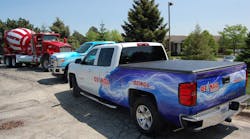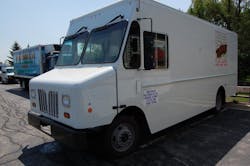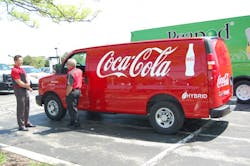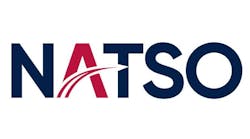Over 200 fleet managers, corporate executives, alternative fuel vehicle (AFV) suppliers, and clean energy experts descended on 2016 Green Drives Convention and Expo held this week at the Northern Illinois University (NIU) conference center in Naperville, IL.
A range of AFVs – including all-electric cars, yard tractors, and medium-duty trucks, plus vehicles powered by propane, natural gas, and a variety of hybrid technologies – were on display, most of them already hard at work in real-world applications.
Moran Transportation Corp. brought its all-electric Orange EV yard tractor to the event; a unit already in service alongside two diesel-powered models at the company’s distribution center near Chicago O’Hare International Airport.
Robert Petzold, Moran’s vice president, told Fleet Owner the company can operate its Orange EV tractor on $5 worth of electricity per its 20 hour shift, compared to its diesel models, which consume one to 2.5 gallons of diesel per hour.
He said that while grant money defrayed part of the cost of acquiring the tractor – lowering the price Moran had to pay by almost half to just under $50,000 – the driver-friendly features of the Orange EV convinced the company to acquire a second unit and maybe possibly a third as well.
“First the battery and electric motor sit between the wheels, so it [the tractor] rides much better compared to the diesel model, where the engine and all the weight is up front,” Petzold said. “It also doesn’t produce a lot of heat so it’s much cooler to operate in the summer.”
Yet in the winter, the Orange EV’s infrared heating system quickly warms the cab and keeps windows free from ice and snow, he said. “That’s because the short trips these tractors go on doesn’t give the diesels time to warm up and produce enough heat in the winter,” Petzold explained.That’s why finding the “right fit” for AFVs is the key to making their deployment a success for a fleet, noted Robert “Bob” McGuire, vice president and director of logistics for Alpha Baking Company.
His fleet recently deployed an all-electric walk-in van (seen at right) designed by the Workhorse Group; a van joining a number of propane-powered models already in use by Alpha.
[To see more photos of vehicles from the event, click here.]
“How you use them [AFVs] is critical; you have to find their ‘sweet spot,’” he told Fleet Owner. In the all-electric van’s case, it will operate in downtown Chicago in a stop-and-start, low mileage pick-up and delivery operations. Since it doesn’t use diesel fuel and won’t require maintenance on diesel-related components – engine, aftertreatment system, etc. – McGuire expects both fuel and maintenance savings to accrue over its expected life cycle.
P.J. Newcomb, sustainability program manager for Coca-Cola North America, noted in a speech at the event that fleet operations play an important role in “green” supply chain strategies at the corporate level, even if when compared to other parts of the supply chain that “role” is relatively small.For example, he noted that in Coca-Cola’s case, distribution – where fleets perform an outsized role – is responsible for only 2% of the carbon produced within the supply chain. By contrast, manufacturing is responsible for 8%, refrigeration 32%, ingredients 28%, and packaging 30%.
“Some would say we have bigger fish to fry, but our trucks are rolling billboards for our company,” he emphasized.
[That includes the 280-odd hybrid service vans, like the one at right, the company has deployed to date.]
That’s why Newcomb said 5% of Coca-Cola’s fleet – some 1,000-plus vehicles – are powered by alternative fuels or use some sort of “advanced technology” such as hybrid systems.
“We need to put over overall sustainability efforts into context,” he explained. “We need to tackle things that save energy and reduce our carbon footprint where we can.”
As an example, the Chicago Area Clean Cities (CACC) group – which along with the South Shore Clean Cities and Wisconsin Clean Cities sponsor the Green Drives event, now in its fifth year – noted at conference that in 2015 its member fleets saved more than 25 million gasoline-gallon equivalents (GGEs) of petroleum and 225,000 tons of greenhouse-gas emissions.
“That is the equivalent of removing 3,000 tanker trucks of gasoline from roads,” noted Samantha Bingham, an environmental policy analyst with the city of Chicago’s department of transportation and CACC’s coordinator.
“This is an example of the success that our coalition’s member fleets are having by using alternative fuels, hybrids, and advanced technologies, which not only helps to save fuel, but also helps to reduce tailpipe emissions,” she added.
John Walton, CACC's vice chairman, noted that the U.S. remains 92% dependent on petroleum to transport goods and people while providing a range of services and people, according to U.S. Department of Energy figures. In 2015, the U.S. imported 2.7 billion barrels of oil at a cost of $131 billion.
“All of these local [green fleet] actions add up,” he said in a statement “The trend towards using more efficient vehicles and alternative fuels continues, despite gas prices being lower than their peak.”





